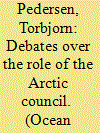| Srl | Item |
| 1 |
ID:
112757


|
|
|
|
|
| Publication |
2012.
|
| Summary/Abstract |
This article examines the role(s) that the member governments want the Arctic Council to have in Arctic Ocean affairs. The article identifies and examines three determining debates over the role and future of the Arctic Council: The first preceded the Arctic Council's creation in 1996, the second occurred during and as a result of the Ilulissat meeting in 2008, and the third followed the political shift in the United States in 2009.
|
|
|
|
|
|
|
|
|
|
|
|
|
|
|
|
| 2 |
ID:
112760


|
|
|
|
|
| Publication |
2012.
|
| Summary/Abstract |
Article 100 of the UN Convention on the Law of the Sea requires parties to "cooperate" against maritime piracy, but how this cooperation is to be achieved is undefined. Enforcement is a public good-creating uncompensated benefits for others, thus suffering from free rider problems. The analysis in this article explains why more pirates captured are released than prosecuted, why the United Nations and the International Maritime Organization are seeking to reduce enforcement costs, why some in the shipping industry want to apply the 1988 Convention Against Terrorism at Sea, and why still others want to move prosecution of pirates from national courts to an international court.
|
|
|
|
|
|
|
|
|
|
|
|
|
|
|
|
| 3 |
ID:
112758


|
|
|
|
|
| Publication |
2012.
|
| Summary/Abstract |
The adoption of an international agreement to create a regime of prior communication and cooperation in the establishment of a precautionary contingency plan for nuclear spills for straits used for international navigation is vital as the peaceful uses of nuclear energy continue to be attractive to states, including Asian states, as a component of a sustainable energy strategy. With the expected rise in nuclear commerce for peaceful purposes, the need for a comprehensive framework for nuclear cargoes and wastes exists and this includes suitable response action plans for nuclear spills. The international instruments adopted by the International Maritime Organisation and the International Atomic Energy Agency provided a framework for the safe and secure carriage of nuclear materials from, other things, piracy, terrorism and sabotage. This article focuses on the movement of vessels carrying nuclear cargoes and wastes through the territorial sea waters of international straits and the necessary relationship that should exist between the vessels and the adjacent coastal States.
|
|
|
|
|
|
|
|
|
|
|
|
|
|
|
|
| 4 |
ID:
112759


|
|
|
|
|
| Publication |
2012.
|
| Summary/Abstract |
Port states have a major role to play in combating substandard ships. Port states have grouped together under various regional memorandums of understanding on port state control to improve the efficiency and effectiveness of each state's port enforcement. Nine regional MOUs have been established that cover nearly all the regions of the world. This article examines the regional MOUs with a focus on their operational strengths and weaknesses.
|
|
|
|
|
|
|
|
|
|
|
|
|
|
|
|
| 5 |
ID:
112756


|
|
|
|
|
| Publication |
2012.
|
| Summary/Abstract |
The three categories of the seafloor highs provided for in Article 76 of the 1982 United Nations Convention on the Law of the Sea should be interpreted from the legal perspective and in light of the principle of the natural prolongation. "Oceanic ridges of the deep ocean floor," which are not part of the natural prolongation of the land territory of the coastal state, are the submarine features that have no geomorphological continuity with the landmass of the coastal state. "Submarine elevations," which are not only part of the natural prolongation of the land territory of the coastal state but also the natural component of the continental margin, are those submarine features that have geomorphological as well as geological continuity with the landmass of the coastal state. "Submarine ridges," which are part of the natural prolongation of the land territory of the coastal state but not the natural component of the continental margin, are those submarine features that have geomorphological continuity with the landmass of the coastal state. There are some clear trends as well as obvious variances in the practice of the Commission on the Limits of the Continental Shelf in this regard.
|
|
|
|
|
|
|
|
|
|
|
|
|
|
|
|